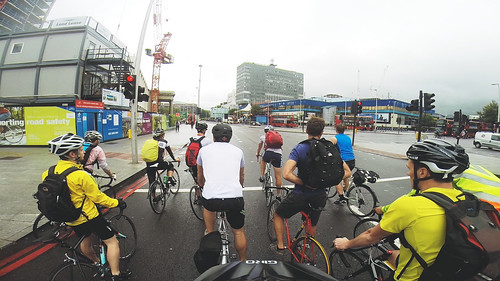When Donald Trump said that Mexico was sending rapists to this country, many people rightly expressed outrage.
Likewise, there would be plenty of righteous umbrage expressed if African-Americans were portrayed as gangsters, "welfare queens" or even basketball players, just as we would not tolerate a broad-brushed characterization of Jews as money-hungry.
However, I've noticed that--at least here in New York--many people, including news anchors, think it's perfectly all right to characterize all cyclists as surly scofflaws. I wish I'd recorded the segment in which an announcer on a local all-news station--the one to which most NYC taxi drivers listen--said that cyclists "never" obey the traffic law and that a proposed law would ensure that we do.
Granted, there are cyclists who blow through red lights and sideswipe pedestrians and others. I don't have any statistics, but I know they don't constitute "all" cyclists, any more than the attacks in Paris or the World Trade Center are proof that "all" Muslims or Arabs, or people from the Middle East or North Africa, are terrorists.
What people forget is in painting all members of a group with a broad brush, they are further alienating themselves from that group, just as they are alienating members of that group from themselves. That, in turn, causes some members of the group--whether they're Muslims or black teenagers or cyclists or whatever--to believe that, no matter how well they behave, they are lumped in with the worst members of their group. So, they figure, there is no point in changing their ways--or they, out of anger, become even bolder or more brazen in their antisocial behavior.
What I heard yesterday on 1010 WINS is not an isolated example, and it is not part of a new trend. About twenty years ago, a certain local television reporter staged an incident in which he, while crossing a street, was knocked down by a "cyclist". (I put "cyclist" in quotation marks because, as the incident was fake, I have to wonder whether the person on the bike was actually a cyclist. Perhaps he was just playing one on TV.) As we were even more of a minority than we are now, there was even less outcry than there has been over more recent examples of anti-cycling bias. Then again, the story had a shorter "shelf life" than today's anti-biker screeds.
So, I urge cyclists to be on the lookout for more examples of anti-bike bias in the meida, and to call the television and radio stations, news-papers and -sites, and other media outlets on it. At the same time, I appeal to my fellow riders to be considerate of pedestrians, especially those who are elderly and disabled--and to obey traffic signs and signals. After all, cyclists in Montreal and Paris do it, and it doesn't seem to slow them down.
Likewise, there would be plenty of righteous umbrage expressed if African-Americans were portrayed as gangsters, "welfare queens" or even basketball players, just as we would not tolerate a broad-brushed characterization of Jews as money-hungry.
However, I've noticed that--at least here in New York--many people, including news anchors, think it's perfectly all right to characterize all cyclists as surly scofflaws. I wish I'd recorded the segment in which an announcer on a local all-news station--the one to which most NYC taxi drivers listen--said that cyclists "never" obey the traffic law and that a proposed law would ensure that we do.
 |
| By Andreas Kambanis |
Granted, there are cyclists who blow through red lights and sideswipe pedestrians and others. I don't have any statistics, but I know they don't constitute "all" cyclists, any more than the attacks in Paris or the World Trade Center are proof that "all" Muslims or Arabs, or people from the Middle East or North Africa, are terrorists.
What people forget is in painting all members of a group with a broad brush, they are further alienating themselves from that group, just as they are alienating members of that group from themselves. That, in turn, causes some members of the group--whether they're Muslims or black teenagers or cyclists or whatever--to believe that, no matter how well they behave, they are lumped in with the worst members of their group. So, they figure, there is no point in changing their ways--or they, out of anger, become even bolder or more brazen in their antisocial behavior.
What I heard yesterday on 1010 WINS is not an isolated example, and it is not part of a new trend. About twenty years ago, a certain local television reporter staged an incident in which he, while crossing a street, was knocked down by a "cyclist". (I put "cyclist" in quotation marks because, as the incident was fake, I have to wonder whether the person on the bike was actually a cyclist. Perhaps he was just playing one on TV.) As we were even more of a minority than we are now, there was even less outcry than there has been over more recent examples of anti-cycling bias. Then again, the story had a shorter "shelf life" than today's anti-biker screeds.
So, I urge cyclists to be on the lookout for more examples of anti-bike bias in the meida, and to call the television and radio stations, news-papers and -sites, and other media outlets on it. At the same time, I appeal to my fellow riders to be considerate of pedestrians, especially those who are elderly and disabled--and to obey traffic signs and signals. After all, cyclists in Montreal and Paris do it, and it doesn't seem to slow them down.


